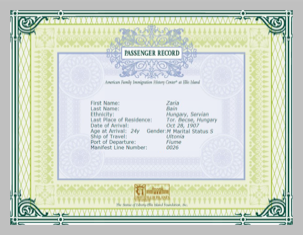About Me
During WW II, my parents, originally from Bečej, Banat (region north of the Danube river just south of the Hungarian border) lived for a couple of years in Niš, Serbia, birth place of Constantine the Great, where my father had a temporary job assignment as an engineer with the Royal Railways of Yugoslavia. There, in 1942 I was born.
My grandfather, Zarija (1882-1943), after whom I was named, died of pneumonia when I was one year old. He was still 60. He became ill during a dark stormy night when he ran across the fields to retrieve his horse carriage, which was blown away by a tornado.
It was over two years after German occupation, and the train which my parents took from Niš to go to my grandfather’s funeral in Bečej, was full of German soldiers. After a few hours of train ride, just north of Belgrade, our train got derailed by partizans, Tito’s freedom fighters.
There were many casualties. According to my parents, our train car was only slightly damaged, and they were not hurt. The furious Germans ordered everybody who was unhurt to rescue the survivors, and gather the dead. My father, Živojin (1917-2006), was ordered to go with a small group of men to the local village to get stretchers. Heeding the warnings of the villagers he did not return to the train. After the cleanup the Germans executed all the civilians from the train, except women with children. My mother, Mila (1917-2004), and I survived.
After WWII, when I was 15 years old, my whole family moved to West Germany, where I received my education and married before immigrating to Canada in 1970. I remember writing an essay for my final year in high school (Abitur in German) with a title “Is it a character flaw to change one’s opinion?”, where I contradicted the expected response by my teacher, Dr. Klein, by concluding: “It is not. I changed my opinion about the Germans.”
Decades later, after I moved to Canada, I found a photo from the cemetery where my grandfather Zarija Bajin, and his father, Vasa Bain (Basil Bain, 1858-1909) were buried, and I noticed that my great-grandfather had no “j” (phonetic “y” as in year) in his last name.
In fact, just recently I discovered my grandfather’s 1907 immigration record into USA via Ellis Island where he was registered under the name Zaria Bain (see picture on the right). - He returned back to Europe to serve in the Austro-Hungarian army in World War 1.
When I showed it to my friend, Malcolm (Mac) Mackay, he, referring to his encyclopedia of Scottish Tartans and Clans, pointed out that over 400 years ago Bains, stemming from Denmark, were one of the 32 families within the Mackay clan. According to that encyclopedia, Scottish mercenaries, being Catholic, often fought for the Polish kings against the insurgent Russians, and as compensation received farmlands in central Europe, where they settled down....
Based on what Mac told me about my lineage, I wanted to verify my “Scottish heritage”, and did the following calculation: Assuming an average of 20 years between generations (only in the more recent times it’s over 25 years), there are approximately 5 generations every century (5 male name bearers). Since every child has two parents, a century ago we all had 32 predecessors, 16 male and 16 female. 200 years ago we all had approximately 32X32 = 1024 predecessors (that’s only 10 family name bearers ago). But if we go 400 years back (20 generations, i.e. name bearers ago), all of us have 1024X1024, over a million predecessors.
This tells us that genetically, family trees beyond a century or two are useless, and that we really are all distant relatives. Two thousand years ago, there were approximately 250 million people on this planet, now there are over 8 billion...
Interesting side note: Approximately ten years ago it was predicted that today, in the year 2020, the two centuries old, multiracial, western, industrial culture, would be economically surpassed by the two millennia old, racially more uniform, eastern, civilization-based culture. It’s not there yet, but it wont take another decade until it happens....
PROLOGUE:
In early 1990 my then 13 years old son, Markus, and I travelled to Glasgow, Scotland, where I participated in a two weeks workshop on New Technology Educational Tools in Paisley. Hearing about our distant ancestry, and in spite of my We’re-All-Related theory, the Scottish hosts presented Markus with a necktie made of a Mackay tartan fabric. It’s all about acquired tradition, logical reason put aside!
In March 1991, for Markus’ 14th birthday, I wrote a poem about
ZACK’S EARLY LIFE 1942 to1960
Stats
NAME: Zaharije - Nickname: Bato
LOCATIONS: Niš, Serbia (birth place of Constantine the Great); Zrenjanin, Banat; Ljubljana, Slovenia; Grevenbroich, Nordrhein - Westfalen. (Regions stay, countries change!)
EDUCATION: K to 13
SUBJECTS: First: Cutting & Pasting, Reading & Writing (first Cyrillic “АБВГД”, then Roman “ABC”), Violin, Solfeggio. Later: Geography, History, Languages (English, French, German, Russian), Mathematics, Physics, and other Secondary School subjects.

My mother, Mila née Bočarski, and I at the end of WW II
My grandfather’s US immigration record in 1907
Zaria Bain, Servian from Hungary, arriving Oct 28, 1907 on the ship Ultonia from Fiume. (Source: http://elisisland.org)
Family tree of 5 generations spans less than one century
Also interesting to note: Based on coats of arms the parents of the above German nobleman are very close relatives
In the Ellis Island US immigration record, I also found my other grandfather, Nova Bočarski. Unbeknowns to each other, he also immigrated to the US in 1907, registered under the name Nova Bocsaracz from Hungary on the Carpathia (the boat that rescued 705 Titanic passangers in 1912 and was torpedoed by the german U-boat U55 in 1918). Nova found working in construction in the US akin to slavery, so he returned home to mary his sweetheart, Zorka, who never wanted to emigrate anyway.
A side note:

